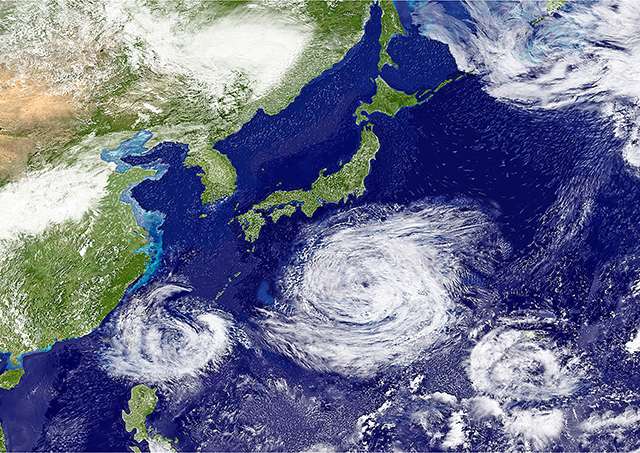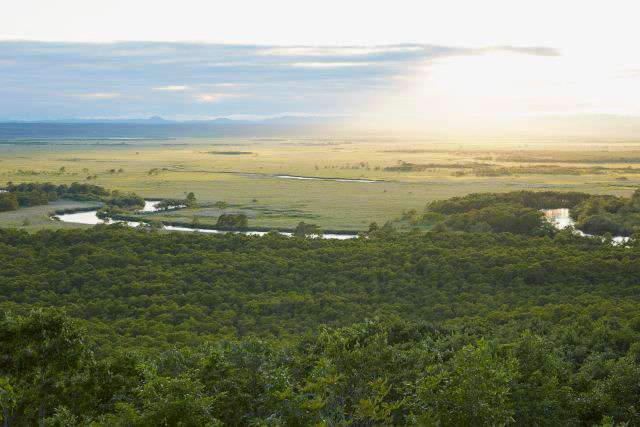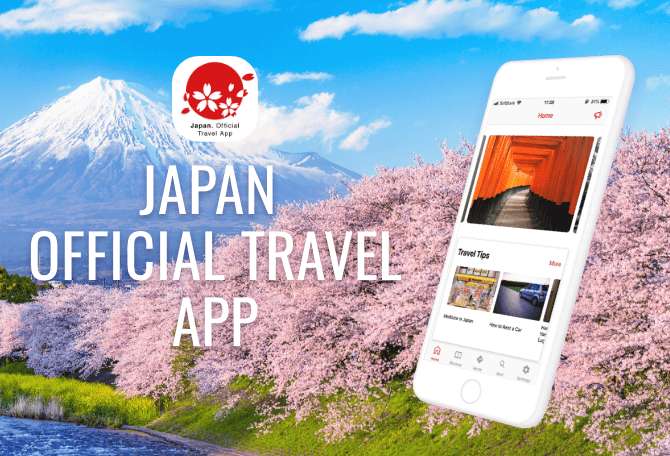Every year, typhoons brew over the Pacific Ocean, and some of these swirling storm systems make their way to Japan. Tropical storms can occur at any time of the year, but most of them form between July and October. Visitors planning a trip to Japan during this time should not be overly concerned about the chances of a typhoon hitting during a visit. An average of 25 typhoons form over the Pacific Ocean every year, but only around three of these make landfall on Japan’s four main islands—Honshu, Hokkaido, Kyushu, and Shikoku. However, some prior knowledge of what to expect from a typhoon, the safety protocols in place, and the support available should aid travel preparations and provide some peace of mind.
Where do typhoons usually strike?
Typhoons tend to affect the subtropical islands of Okinawa and the country’s southernmost main island of Kyushu, so visitors planning trips to these areas should be aware of the possibility of travel disruption. While the major Japanese cities of Tokyo, Osaka, and Kyoto remain relatively protected from typhoons, storms causing inclement weather and damage in these cities are not unheard of. In 2019, Typhoon Hagibis, one of the strongest typhoons in recent history, ripped through greater Tokyo.

What happens during a typhoon?
The Japan Meteorological Agency tracks typhoons closely, providing regular updates via television and the internet. If a typhoon's trajectory appears likely to make landfall, the government acts quickly to ensure public safety. Schools and businesses may be temporarily closed, public transportation suspended, and evacuation warnings issued for areas near rivers or at risk of landslides.
As a typhoon moves over a specific area, strong winds are accompanied by lashing rain. Depending on the strength of the storm, the excess water pouring into waterways can lead to landslides or overflowing rivers. Trees are sometimes toppled by the wind, blocking roads and rail tracks, and occasionally injuring people, damaging buildings, or causing power outages.

Staying safe during a typhoon in Japan
If you are in Japan when a typhoon strikes, keep aware of the situation by using television or internet resources. Avoid going outside, either on foot or in a private vehicle. If you need to use public transportation, give yourself ample time to reach your destination before services are temporarily suspended. If necessary, stock up on food and water essentials; however, resist panic-buying.
Your accommodation should be adequately prepared, so check with the staff about protocols. If you are unsure, or if you are staying in self-serviced accommodation, you can contact the Japan Visitor Hotline. The service is run by the Japan National Tourism Organization (JNTO) and is available in English, Chinese, Korean and Japanese. Call up for support and assistance regarding natural disasters as well as for general tourism information. JNTO’s social media channels (Twitter , Weibo) and the Japan Official Travel App provide up-to-date information on natural disasters, as well as travel advisories, warnings, and other safety and security information benefitting travelers in Japan. The app can be downloaded onto smartphones and is available in English, simplified Chinese, traditional Chinese, and Korean.
Generally speaking, typhoons tend to pass through in less than 24 hours, so you won’t have to shelter for too long. However, your travel plans will likely be affected if a typhoon is approaching, so it is a good idea to have a Plan B. Consider a virtual tour of some of Japan’s most famous sites while you are waiting for the storm to pass. The day after a typhoon is usually bright and sunny, so make this a day for outdoor activities.
Typhoons throughout Japanese history
Accounts of Typhoons battering the Japanese archipelago have been documented throughout the country’s history, and not always with a negative outcome. In the 13th century, locals attributed two typhoons to an act of the divine when strong winds scuppered an invasion attempt from the Asian continent by destroying thousands of ships. This was one of the first references to “kamikaze,” or “divine wind”.
Typhoons, cyclones, and hurricanes: what’s the difference?
Hurricanes in the United States or the Caribbean, cyclones in Australia or India, and typhoons in the Philippines or Japan make the news each year. The separate terms imply that there is some difference between them; however, they are all the same type of storm. They are large weather systems that bring heavy rain and strong winds and have an “eye” at the center. The difference is solely to do with location. Typhoons form in the western Pacific Ocean, cyclones form in the southern hemisphere around Australasia and in the Indian Ocean, and hurricanes form in the mid-Atlantic Ocean. Their trajectories are affected by the spin of the earth, which is why each system tends to strike in the same geographical regions.
Climate change and typhoons
Scientific studies suggest that typhoons, hurricanes, and cyclones will increase in intensity and frequency in the years to come due to global warming. As a country directly affected by typhoons, Japan is keenly aware of the dangers and is instituting various initiatives therefore trying to reduce its overall greenhouse gas emissions. The tourism industry in particular is playing its part through campaigns to increase local production for local consumption and the encouragement of longer-stays.
Japan: living with nature
While Japan is prone to typhoons and other natural disasters, the country has adapted to coexist with nature and has tried and tested disaster protocols effective in keeping the public safe. It should be noted that tectonic activity that causes earthquakes and volcanoes has helped shape Japan into the extraordinary travel destination it is. It has given the country unique rock formations in places such as Wakayama and Hokkaido’s Shiretoko Peninsula, the beautiful mountain scenery of Mt. Fuji and Kyushu’s Mt. Aso, giant caldera lakes such as Lake Kussharo and Lake Mashu in Hokkaido, and the therapeutic hot spring baths across the country.

-
About the author
Jeremy has enjoyed 15 Japanese summers. After a decade of trying to master the Japanese language, he has realized it will likely take another decade to get there.






























































